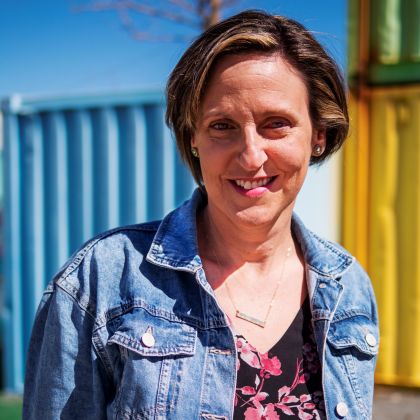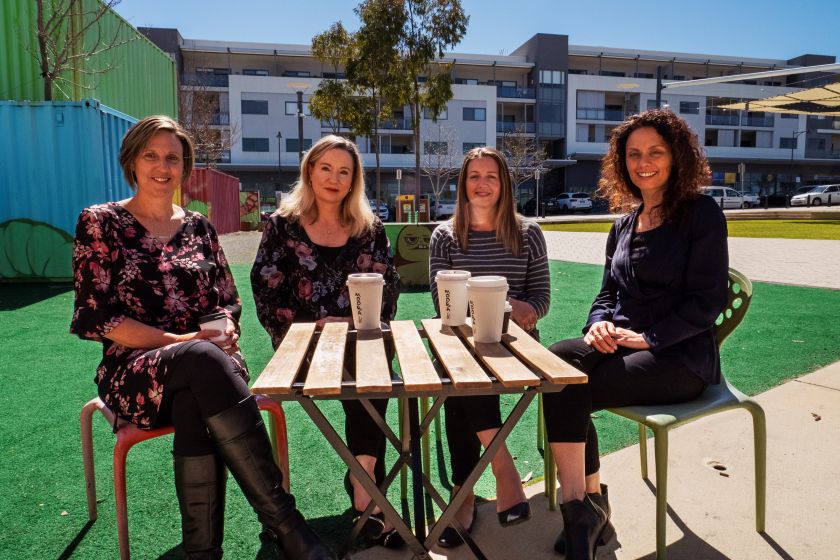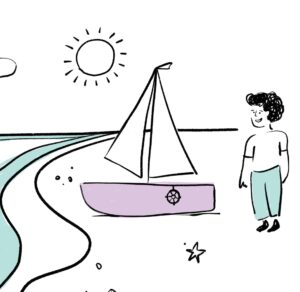It is now more widely known that 1 in 2 of us will experience a mental disorder during our lifetime, however it is not always known how young these issues start. 50% of people who have mental disorder in their lifetime will have their first episode by the age of 18, and 75% by the age of 25.[1]
These issues can start early, so we need to get help early in order to minimise the impacts and to build our skills and supports. Many parents joke that kids don’t come with a manual and often feel that they’re making it up as they go along. Parenting can certainly feel like the ultimate long-term apprenticeship so getting support and education along the way can be beneficial.
We chatted with psychologist Gemma Downie from Lit Therapy, a service specifically targeted at providing support for young people and their families.
Gemma Downie – Lit Therapy

Gemma is a Registered Psychologist with over 20 years experience working in Mental Health, Employment, Disability and Private Practice.
She is skilled and experienced in Acceptance and Commitment Therapy (ACT), Cognitive Behavioural Therapy (CBT), EMDR and Schema Therapy and works with adults and young people in a practical, solution focussed way.
She has 4 kids (3 of whom are teenagers) and uses humour and warmth to connect with people.
What is the rationale behind setting up the practice?
GEMMA: Working in private practice I could see that generic psychology services were not quite meeting the needs of young people. Our local youth specific community services have long waits and are often only able to service those young people that are very distressed.
It was evident that there is a major gap in services and supports for a young person that isn’t “right” at the moment, but there is nowhere to take them to sort out the issues before things escalate. A clinical, medical environment also didn’t feel right for this group, especially if we want them to feel comfortable and engage.
Parents needed a responsive service that was able to help when needed in a way that was needed. Lots of local practitioners who have “adolescents” as part of their suite of services but through my work I have come to realise that the needs of young people are pretty specific.
Evidence is also building that young people are at increasing risk of self harm, suicide, bullying and mental health issues and I wanted to be a part of an alternate solution to current services.
As adults we have control over what is going on and understand when things are deteriorating. Young people are still figuring out who they are and what is important. Adolescence is a confusing time without environmental triggers or mental health issues compounding the emotions and responses.
Relevant? Having my own teenagers and friends/family with young people in their lives on an anecdotal level I can see that there are so many challenges that face kids and parents, so a specific and specialised service is warranted.
Why is that important?
GEMMA: According to The World Health Organisation (WHO) the consequences of not addressing adolescent mental health conditions extend to adulthood, impairing both physical and mental health and limiting opportunities to lead fulfilling lives as adults.
There are a number of statistics that demonstrate why this kind of service is so important. I don’t believe we can leave it to government and community services to be the only ones to provide a solution when we know that mental health promotion and prevention are key to helping adolescents thrive.
Half of all lifelong mental health problems begin before the age of 14,[2] with one in seven young people aged 4 to 17 years experiencing a mental health condition in any given year. 6.9% of children and young people (aged 4 to 17 years) had suffered from an anxiety disorder in the past 12 months.[3]
Over 75% of mental health problems occur before the age of 25.[2] One in ten young people aged 12-17 years old will self-harm, one in 13 will seriously consider a suicide attempt, and one in 40 will attempt suicide.[3]
Shockingly, suicide continues to be the biggest killer of young Australians with suicide being responsible for one-third of all deaths of young people aged 15-24 years,[4] more than cancer, road accidents, violence…
It’s also a time of more change and growth than any other time in life, physically and emotionally. Issues like intimate relationships, gender, sexuality, educational pressures, family conflict, personality development, friendship changes, goal setting, motivation, career decisions and a range of other stresses and changes make this unique time in life particularly challenging.
But we know that young people are less likely than any other age group to seek professional help. Only 31% of young women and 13% of young men with mental health problems had sought any professional help.[5]

What do you hope to achieve?
GEMMA: Thriving practice with lots of opportunities for young people to get the support they need in whatever way they need it… individual sessions, groups, support and info for parents, minimal wait and responsive to “crisis” if needed. A comfortable and safe space where young people can come to learn strategies that will see them through life. Support mechanisms for parents who are also often struggling as well as they watch their young person struggle. More community connection and personal interaction in a sometimes disconnected world. Less distress, less self harm and ultimately less suicide.
What will be different about this practice to other psychology practices?
GEMMA:
The environment – funky, non-clinical, non-medical space. Resources available for purchase for parents and young people wanting information.
Range of services offerings – working towards groups, info sessions, written resources available for purchase on site, safe space, peer supports, as well as individual therapy.
Specific focus on youth – knowledge, expertise and service offerings all focus on improving the mental health of young people, including the services and information tailored for parents. Experience and knowledge in finding the balance for the young person and their families…can be a minefield.
Accessibility – Open 9-9, allows for the priority of kids being at school. We also want to acknowledge that “life” doesn’t happen 9-5 and sometimes families need a place to go outside of business hours. Less than 200m from the train station at Cockburn Central so accessible for students. Also ground level so easily accessible for people with mobility challenges.
Minimal wait for services – which is consistent with private practice, but not youth mental health services in general. There will also be continuity of service, which often public services are unable to offer.
What do you wish people knew about young people’s mental health?
GEMMA: Can be more fragile than we think. Attention seeking behaviours, aggression, and withdrawal are often put down to “teen” behaviour, but often they are signs that someone needs some help and are struggling to manage their world. An issue may seem small or trivial to us, but young people can place different meaning in things.
What can parents do to better support mental health of their young people?
GEMMA: According to Reachout, 70% of young people will not access support but if they do they will turn to their parents first. Your response can be crucial. Try to remember what it is like to be young. Perspective is different and emotions are high!
Be patient, breathe and take care of yourself as a parent/adult so you have the resources to support your young person. Be with your young person, even if life is busy and they appear not to need you… make time for them to do the things that interest them. It’s not always in the talking about “the big stuff”, but often the quiet moments side by side that help your young person feel connected.
Be interested, even when they don’t want you to be! Ask questions about their friends and interests. Try to create moments to laugh together, even if you are in battles over certain things. Memes, TV shows of interest, sporting events, music, Instagram… so many things to learn about. Sometimes parents are afraid or unsure of how to “parent” this age group – they can seem so independent. But young people are still developing and require modelling, discipline and boundaries from trusted adults. This is what young people need to develop into healthy adults.
Reachout.com recommends parents:
- develop and maintain secure and stable relationships with their teenagers by learning more about what they might be experiencing or issues they might be going through
- support their teenager and teach them how to seek help and work through issues independently
- learn about mental health issues that often have their onset during adolescence, including what to be aware of, and how parents can get help for their teenager if and when they need it
Are mental health problems more common now? If so, why?
GEMMA: Suicide rates among young people are at the highest they’ve been for over a decade, and now account for around one third of all deaths in those aged 15 to 24.[4] The evidence for mental health problems being more common now can be reflected in this increase in the suicide rates amongst young people, but also higher levels of depression and anxiety in young people being reported. The higher reporting levels of depression and suicide could be an actual increase or could be attributed to increased reporting as awareness and help seeking behaviour grows.
It is hard to attribute the reason for an increase in mental health problems for youth. As with the increase in mental health problems for adults, the reasons are complex.
From experience, I would suggest social media impacts on the mental health of young people in a slightly different way to adults. Exposure to events, opinions, images and concepts that young brains are not equipped to handle can have a large impact on the developing mind. Social media also creates a culture of comparison (my life versus the life presented to me on social media) which can rob young people of appreciation and gratitude for many of the positive and supportive factors they have in their life, thereby subtly undermining their mental health.
This is a complex area as although social media and technology can be seen as part of the problem, they are also going to need to be part of the solution.
There also appears to be more pressure on families in general, creating financial, relationship, achievement and status stress.
Another reason may be that parents are under more pressure and experiencing more mental health issue themselves, making it hard to see what is going on for the young people in their lives. As life gets busier, unfortunately we become less engaged, less connected with the everyday events that are occurring for a young person.
There has been limited research behind the increase in mental health problems, however factors such as social media, digital communication and adolescents sleeping less than previous generations are all areas of interest.

Lit Therapy
Location: 2/2 Points Way Cockburn Central
Phone: 0416 485 778
Website: https://www.littherapy.com.au/
Email: hello@littherapy.com.au
Facebook: https://www.facebook.com/littherapy
Instagram: @littherapycockburn
References:
- Kitchener B.A, Jorm A.F, Kell C.M. Mental Health First Aid Manual. 4th ed. Melbourne: Mental Health First Aid Australia; 2019.
- Kessler, RD et al. (2005). Lifetime prevalence and age-of-onset distributions of DSM-IV disorders in the National Comorbidity Survey Replication. Archives of General Psychiatry, 62: p. 593-602.
- Lawrence D, Johnson S, Hafekost J, Boterhoven De Haan K, Sawyer M, Ainley J, Zubrick SR. (2015). The Mental Health of Children and Adolescents. Report on the second Australian Child and Adolescent Survey of Mental Health and Wellbeing. Canberra: Department of Health.
- Australian Bureau of Statistics. (2015). Causes of Death, Australia, 2014. Catalogue No. 3303.0.Canberra: ABS. Accessed 2 March 2015 from http://www.abs.gov.au/ausstats/abs@.nsf/mf/3303.0?OpenDocument
- Slade T, Johnston A, Teesson M, Whiteford H, Burgess P, Pirkis J, et al. (2009) The Mental Health of Australians 2: Report on the 2007 National Survey of Mental Health and Wellbeing. Canberra: Department of Health and Ageing.
-
 Building Buoyancy | eLearning Course*$180.00 inc.GST
Building Buoyancy | eLearning Course*$180.00 inc.GST -
 Workplace Mental Health for Leaders | eLearning Course + Assessments$770.00 inc.GST
Workplace Mental Health for Leaders | eLearning Course + Assessments$770.00 inc.GST
Tap into our mental health expertise
Top Image: Patricia Prudente (Unsplash).
Other images: Gemma Downie


